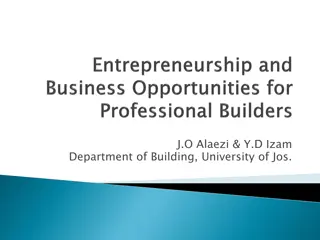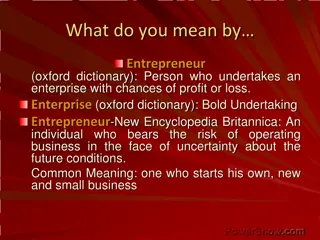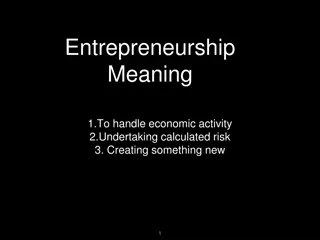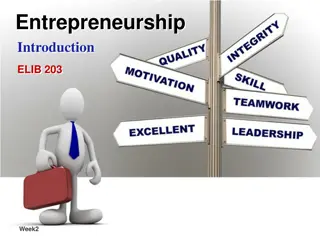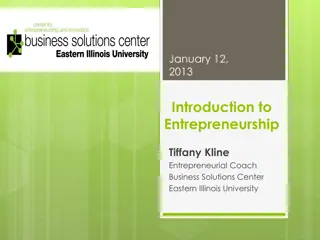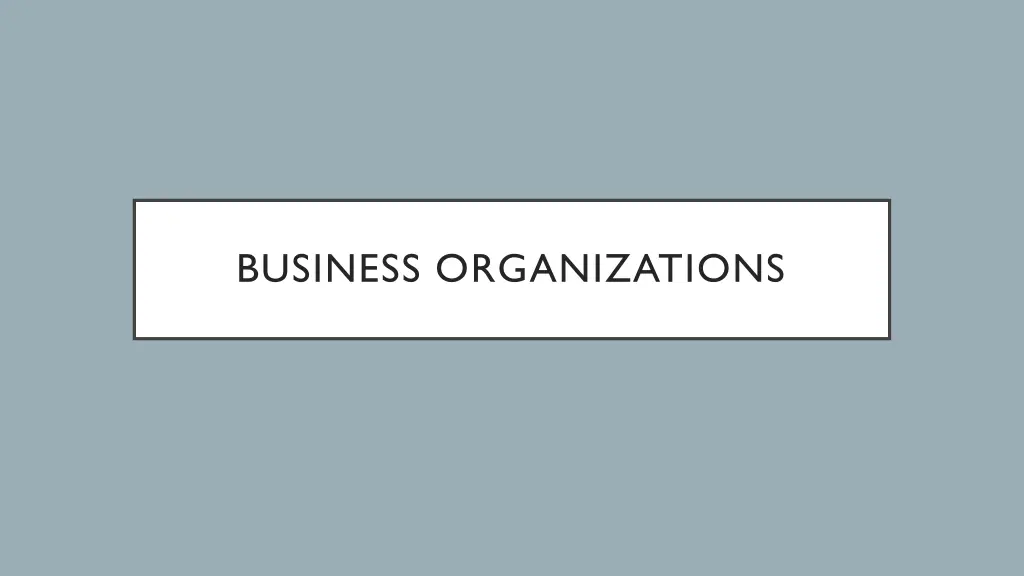
Entrepreneurship and Business Organizations Guide
Discover what it takes to be an entrepreneur and the different types of business organizations available, such as sole proprietorships and partnerships. Learn about the advantages and disadvantages of each structure to help you make informed decisions when starting a new business.
Download Presentation

Please find below an Image/Link to download the presentation.
The content on the website is provided AS IS for your information and personal use only. It may not be sold, licensed, or shared on other websites without obtaining consent from the author. If you encounter any issues during the download, it is possible that the publisher has removed the file from their server.
You are allowed to download the files provided on this website for personal or commercial use, subject to the condition that they are used lawfully. All files are the property of their respective owners.
The content on the website is provided AS IS for your information and personal use only. It may not be sold, licensed, or shared on other websites without obtaining consent from the author.
E N D
Presentation Transcript
WHAT IS AN ENTREPRENEUR? An entrepreneur is a person who has the skill-set to successfully start up and manage a business and they possess these qualities Seek out responsibility Are willing to take risks Believe in themselves Desire to reach their full potential Have high energy Look toward the future are forward thinking Value achievement over money Maintain flexibility when they face a new challenge Committed to their goals
STARTING UP A NEW BUSINESS Entrepreneurs have to make a lot of decisions when they start up a new business including what type of business they intend to create. A business organization is an establishment that is formed to carry out commercial enterprises in other words, business organizations are firms. There are different types of business organizations: Sole proprietorships Partnerships Corporations, Mergers & Multinationals Franchises, Co-Ops, and Non-Profits
SOLE PROPRIETORSHIP Most common business organization; owned and operated by a single individual. (About 75% of all businesses in America) The owner earns all the profits and deals with all of the firm s debts. Advantages Easy start-up (few government requirements license, permit, and business name) Few Regulations least regulated form of business; does have to adhere to basic regulations (minimum wage, labor laws, etc.) Earn all the Profit Disadvantages Total personal liability legally bound to pay all debts, even if the business fails. Limited access to resources small businesses have to pay out of pocket to expand their businesses, this can be unattainable for some Lack of permanence the owner dies, there may not be anyone to carry on the business Total control Easy to close the business
PARTNERSHIPS A business organization owned by two or more people. (7% of businesses in America) There are three categories: general, limited, and limited liability partnerships. General Partnership Most common type Limited Partnership Only one partner is required to be the general partner. Only one partner assumes the liability and responsibility. Limited Liability Referred to as LLPs; new type of partnerships All partners are limited partners except when it comes to their personal liability. Not all businesses can register as an LLP. Most states allows professionals like attorneys or doctors to create LLPs. Partners share the liability and responsibility equally. Examples: doctors practice, law firm, accounting firm, etc. Limited partners can only lose their initial investment. Main advantage is control;drawback is extent of liability.
PARTNERSHIPS Partnerships are easy to start-up, allow for shared decision making opportunities, allow for specialization to occur and allow for partners to pool their assets and wealth. Disadvantages include the fact that liability is unlimited, especially for the general partner and there is a great potential for conflict.
CORPORATIONS A corporation is a legal entity that is owned by individual stockholders each of who have limited liability for a firm s debts. Stockholders are people who own stock (certificate of ownership in a company). Essentially, stockholders are part-owners. Corporations exist independently of the individual owner(s) but they operate like an individual. They must pay taxes, engage in trade and business, make contracts, sue other parties or businesses and get sued. Only 20% of all businesses in America are corporations but they sell 90% of all products sold in our nation.
CORPORATIONS There are advantages and disadvantages to the owner and stockholders of corporations/incorporations Advantages Limited liability for the owners Easy to transfer ownership Disadvantages Expense and difficulty to start-up Double taxation corporations pay dividends to their stockholders and increased income (profit) taxes Potential loss of control by the founders stockholder take over More legal requirements and regulations Ability to attract capital Long-life business venture Sometimes corporations may merge which means join together. When two or more firms in the same industry join its called a horizontal merger. Vertical mergers occur when two or more firms join that are in different production stages. When large firms buy out other firms, these combinations are known as conglomerates.
FRANCHISES A business franchise is a semi-independent business that pays fees to a parent company. In return, the business is granted the exclusive right to sell a certain product or service in given area. Franchises are good because the franchisers (owners) provide management and training, they provide the product, it s nationally recognized product, and they advertise for you. Drawbacks include high franchising fees (called royalties), strict standards, purchasing restrictions, and limited product line.
COOPERATIVE ORGANIZATIONS Often called a co-op owned by lots of individuals for their shared benefits. There are consumer co-ops that sell merchandise to members at discounted prices (examples: Sam s or Costco, Disney Movie Club, New Leaf Market) Service co-ops provide a service rather than products services might include babysitting club, legal groups, health care services, etc. Finally producer co-ops are agricultural groups that focuses on growing their crops or raising living stock.
NON-PROFIT ORGANIZATIONS Some groups function like a business organization but they do not operate for the sole purpose of generating a profit. Instead, they usually benefit society. Red Cross Big Brother/Sisters Schools Hospitals Religious Institutions YMCAs These groups are often exempt from income taxes because they do not bring in a profit. Some non-profits work to provide professional support for certain professions union groups, business associations, and trade groups are all non-profits.
NOT EVERY IDEA HAS THE POTENTIAL TO SPAWN A BUSINESS
GOVERNMENT REGULATION AND COMPETITION When looking at the market structures, we saw many opportunities for businesses to take advantage of the consumer. Especially those with market power, like monopolies and oligopolies. The federal government has instituted many policies to keep firms from controlling the price and supply of important goods. These policies are known as antitrust laws, because a trust is a business combination similar to that of a cartel. These policies have been designed to: Break up Monopolies: companies like AT&T, the American Tobacco Company and others have directly been broken up by the federal government into smaller companies to increase competition. Block mergers: prevent firms from joining together to act as a monopoly.
GOVERNMENT REGULATION AND COMPETITION Since the 1970 s we have also experienced deregulation or the removal of government decision making in certain industries. In certain cases, new technologies have made regulation no longer necessary, such as cell phone technology reducing the impact of a landline monopoly. Both antitrust laws and deregulation, although opposites, work to increase competition in different markets!



